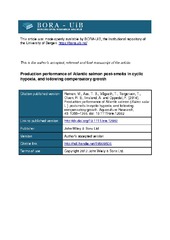Production performance of Atlantic salmon post-smolts in cyclic hypoxia, and following compensatory growth
Remen, Mette; Aas, Turis Synnøve; Vågseth, Tone; Torgersen, Thomas; Olsen, Rolf Erik; Imsland, Albert; Oppedal, Frode
Peer reviewed, Journal article
Accepted version
Permanent lenke
http://hdl.handle.net/1956/9536Utgivelsesdato
2014-07Metadata
Vis full innførselSamlinger
Originalversjon
https://doi.org/10.1111/are.12082Sammendrag
This study investigated the production performance of the Atlantic salmon postsmolt (Salmo salar L.) subjected to cyclic oxygen reductions (hypoxia) of varying severity. Triplicate groups (N = 955) were kept at constant 80% O2 (control) or subjected to 1 h and 45 min of hypoxia (50, 60 or 70% O2, termed 80:70, 80:60 and 80:50 groups) every 6 h at 16°C for 69 days. Feed was provided in normoxia. One third of the fish were kept further for 30 days in normoxia to study possible compensatory growth. Cyclic hypoxia did not alter the oxygen uptake rates of fish, measured in night-time. Fish subjected to 50% and 60% O2 reduced feeding by 13% and 6% compared with the controls, respectively, with corresponding reductions in specific growth rates. Feed utilization was not reduced. Compensatory growth was observed in fish from the 80:50 group, but full compensation was not achieved. The main conclusions were that feeding in normoxia does not fully alleviate negative effects of cyclic hypoxia on feeding and growth, when oxygen is reduced to 60% or below in hypoxic periods, that feed utilization is maintained, and that compensatory growth may lessen negative effects.
